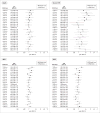Association between Off-Peak Hour Birth and Neonatal Morbidity and Mortality among Very Low Birth Weight Infants
- PMID: 28284476
- PMCID: PMC5500004
- DOI: 10.1016/j.jpeds.2017.02.007
Association between Off-Peak Hour Birth and Neonatal Morbidity and Mortality among Very Low Birth Weight Infants
Abstract
Objective: To assess the independent association between overnight or "off-peak" hour delivery and 3 neonatal morbidities strongly associated with childhood neurocognitive impairment.
Study design: Retrospective population based cohort study of all infants with birth weights of 500-1499 g born without severe congenital anomalies in California or Pennsylvania between 2002 and 2009. Off-peak hour delivery was defined as birth between 12:00 a.m. and 6:59 a.m. The study outcomes were death; bronchopulmonary dysplasia, retinopathy of prematurity, and severe (grade 3 or 4) intraventricular hemorrhage among survivors; the composite of each morbidity or mortality; and the composite of death or 1 or more of the evaluated morbidities.
Results: Of 47 617 evaluated infants, 9317 (19.6%) were born during off-peak hours. The frequencies of all study outcomes were higher among infants born during off-peak compared with peak hours. After adjusting for maternal, infant, and hospital characteristics, off-peak hour delivery was associated with increased odds of severe intraventricular hemorrhage among survivors (OR 1.39, 95% CI 1.23-1.57) and the composite outcomes of death or severe intraventricular hemorrhage (OR 1.16, 95% CI 1.07-1.25) and death or major morbidity (OR 1.08, 95% CI 1.02-1.15). There was no evidence of subgroup effects based on delivery mode, birth hospital neonatal intensive care level or annual very low birth weight infant delivery volume, or weekday vs weekend off-peak hour delivery for any study outcome.
Conclusions: Very low birth weight infants born between midnight and 7:00 a.m. are at increased risk for severe intraventricular hemorrhage and death or major neonatal morbidity.
Keywords: bronchopulmonary dysplasia; intraventricular hemorrhage; overnight birth; retinopathy of prematurity.
Copyright © 2017 Elsevier Inc. All rights reserved.
Conflict of interest statement
The authors declare no conflicts of interest.
Figures





Comment in
-
Large Data and the Risks of Misleading Conclusions.J Pediatr. 2017 Jul;186:7-9. doi: 10.1016/j.jpeds.2017.03.041. Epub 2017 Apr 7. J Pediatr. 2017. PMID: 28396021 No abstract available.
Similar articles
-
Effects of a Birth Hospital's Neonatal Intensive Care Unit Level and Annual Volume of Very Low-Birth-Weight Infant Deliveries on Morbidity and Mortality.JAMA Pediatr. 2015 Aug;169(8):e151906. doi: 10.1001/jamapediatrics.2015.1906. Epub 2015 Aug 3. JAMA Pediatr. 2015. PMID: 26237466 Free PMC article.
-
Racial and Ethnic Disparities in Preterm Infant Mortality and Severe Morbidity: A Population-Based Study.Neonatology. 2018;113(1):44-54. doi: 10.1159/000480536. Epub 2017 Oct 27. Neonatology. 2018. PMID: 29073624
-
Adverse effects of small for gestational age differ by gestational week among very preterm infants.Arch Dis Child Fetal Neonatal Ed. 2019 Mar;104(2):F192-F198. doi: 10.1136/archdischild-2017-314171. Epub 2018 May 5. Arch Dis Child Fetal Neonatal Ed. 2019. PMID: 29730594 Free PMC article.
-
Genetic approaches to complications of prematurity.Front Biosci. 2007 Jan 1;12:2344-51. doi: 10.2741/2236. Front Biosci. 2007. PMID: 17127244 Review.
-
Neonatal Golden Hour: a review of current best practices and available evidence.Curr Opin Pediatr. 2023 Apr 1;35(2):209-217. doi: 10.1097/MOP.0000000000001224. Epub 2023 Feb 1. Curr Opin Pediatr. 2023. PMID: 36722754 Review.
Cited by
-
Weekend and off-hour effects on the incidence of cerebral palsy: contribution of consolidated perinatal care.Environ Health Prev Med. 2020 Sep 10;25(1):52. doi: 10.1186/s12199-020-00889-y. Environ Health Prev Med. 2020. PMID: 32912144 Free PMC article.
-
Birth during on-call period: Impact of care organization on mortality and morbidity of very premature neonates.Front Pediatr. 2022 Aug 18;10:977422. doi: 10.3389/fped.2022.977422. eCollection 2022. Front Pediatr. 2022. PMID: 36061390 Free PMC article.
-
Association between time of delivery and poor perinatal outcomes -An evaluation of deliveries in a tertiary hospital, South-east Nigeria.PLoS One. 2019 Jun 10;14(6):e0217943. doi: 10.1371/journal.pone.0217943. eCollection 2019. PLoS One. 2019. PMID: 31181101 Free PMC article.
-
Mortality and Morbidities according to Time of Birth in Extremely Low Birth Weight Infants.J Korean Med Sci. 2021 Apr 5;36(13):e86. doi: 10.3346/jkms.2021.36.e86. J Korean Med Sci. 2021. PMID: 33821593 Free PMC article.
-
The Effect of Birth Hour on Neonatal Morbidity and Mortality in Very-Low Birth Weight Infants in a Teaching Hospital.Turk Arch Pediatr. 2023 Sep;58(5):527-530. doi: 10.5152/TurkArchPediatr.2023.23071. Turk Arch Pediatr. 2023. PMID: 37584469 Free PMC article.
References
-
- Mathew T, Curtin S. When are babies born: Morning, noon, or night? Birth certificate data for 2013. Hyattsville, MD: National Center for Health Statistics; 2015. (NCHS data brief, no 200). - PubMed
-
- Lee SK, Lee DSC, Andrews WL, Baboolal R, Pendray M, Stewart S, et al. Higher mortality rates among inborn infants admitted to neonatal intensive care units at night. J Pediatr. 2003;143:592–7. - PubMed
-
- Paccaud F, Martin-Béran B, Gutzwiller F. Hour of birth as a prognostic factor for perinatal death. Lancet. 1988;1:340–3. - PubMed
-
- Gould JB, Qin C, Chavez G. Time of birth and the risk of neonatal death. Obstet Gynecol. 2005;106:352–8. - PubMed
Publication types
MeSH terms
Grants and funding
LinkOut - more resources
Full Text Sources
Other Literature Sources
Medical

